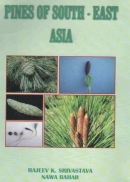Pines of South East Asia
Authors : Srivastava, (Dr.) P.K. , Bhar, Dr. Nav
ISBN : 81-7089-343-7
Published Year : 2007
Pages : pp.xiv+272 with 20 coloured plates.
Rs.1,500.00
Price includes all taxes.

Pines are unique species of high economic, ecological, cultural and spiritual significance. They provide a multitude of benefits to human beings, including highly nutritious nut like seeds of Chilgoza and durable fragrant wood, as well as other products. At the same time pine forests often have been and continue to be abused and managed for timber production, which destroys the pine production. The growth of world demand for pine nuts and stable high price call for better management of existing pine resources and for their cultivation within and outside native range. Pine was first investigated by Hippocrates, the father of Western medicine, for its benefits to the respiratory system. During the 1800's, tar from the pine was used in many medicines, especially for skin diseases like eczema and psoriasis. The needles were made into stuffing called pine wool that was thought to repel lice, fleas and other pests.
Pines are the pioneer species over much of their natural range and are active colonizers of degraded sites particularly the drier south facing slope. The species have thus great promise in afforestation programmes in their natural habitats. Much of the degraded areas in their habitat are deficient in organic matter, water holding capacity, nutrient availability and micro/macro fauna and are thus lacking in almost all the desirable physical, chemical and biological characteristics necessary to support species other than pines, which also do not always respond favourably to afforestation efforts. Increasing survival of out planted seedlings, reduction in cost of raising nursery and plantations, increasing productivity, etc. are some of the major concern of foresters, scientists and planners today.
Pines being an important component of the Himalayan ecosystem, cost effective techniques of afforestation, and use of improved site matched planting material assume significance in the endeavours undertaken in the ecological rehabilitation of Himalayan region. Main species of pines found are Chir pine, Blue pine, Chilgoza pine and Khasi pine in India.
Pines are the pioneer species over much of their natural range and are active colonizers of degraded sites particularly the drier south facing slope. The species have thus great promise in afforestation programmes in their natural habitats. Much of the degraded areas in their habitat are deficient in organic matter, water holding capacity, nutrient availability and micro/macro fauna and are thus lacking in almost all the desirable physical, chemical and biological characteristics necessary to support species other than pines, which also do not always respond favourably to afforestation efforts. Increasing survival of out planted seedlings, reduction in cost of raising nursery and plantations, increasing productivity, etc. are some of the major concern of foresters, scientists and planners today.
Pines being an important component of the Himalayan ecosystem, cost effective techniques of afforestation, and use of improved site matched planting material assume significance in the endeavours undertaken in the ecological rehabilitation of Himalayan region. Main species of pines found are Chir pine, Blue pine, Chilgoza pine and Khasi pine in India.


